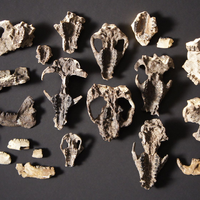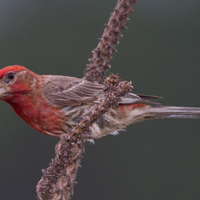Login
Subscribeevolution
Gene Regulation Gives Butterflies Their Stunning Looks
Katarina Zimmer | Nov 14, 2019 | 5 min read
Distantly related, lookalike Heliconius species arrive at the same appearance using the same few genes, but regulated differently, according to recent studies.

Ape Fossils Shed New Light on Evolution of Bipedalism
Catherine Offord | Nov 7, 2019 | 2 min read
The 12-million-year-old bones of a previously unknown species named Danuvius guggenmosi challenge the prevailing view about when and where our ancestors first started walking upright.

Image of the Day: Fractal Formation
Emily Makowski | Nov 4, 2019 | 1 min read
A mixture of chemicals induces reactions reminiscent of life on pyrite.

Infographic: How the Mitochondrial and Nuclear Genomes Interact
Viviane Callier | Nov 1, 2019 | 3 min read
From regulating each other’s gene expression to encoding different parts of the same proteins, the two genome types in every eukaryotic cell are far from independent.

Martha Muñoz Uncovers the Drivers and Dampers of Biodiversity
Nicoletta Lanese | Nov 1, 2019 | 3 min read
The Yale biologist says that organisms’ behavior, physiology, and morphology engage in a constant “evolutionary dance.”

The Two Genomes in Every Eukaryotic Cell
Viviane Callier | Nov 1, 2019 | 10+ min read
Interactions between mitochondrial and nuclear genomes have further-reaching effects on physiological function, adaptation, and speciation than previously appreciated.

Trove of Fossils Shows Mammal Evolution after Dino Extinction
Emily Makowski | Oct 25, 2019 | 2 min read
The site, Corral Bluffs in Colorado, also reveals how plants evolved and how ecosystems rebounded after the asteroid impact.

Image of the Day: Flight Styles
Emily Makowski | Oct 25, 2019 | 2 min read
The evolution of different ways of flying in birds affected wing range of motion, but not wing shape.

Image of the Day: Puma Genome Sequencing
Emily Makowski | Oct 21, 2019 | 2 min read
The big cats show signs of inbreeding despite conservation efforts to diversify their populations.

Image of the Day: Brains and Braincases
Emily Makowski | Oct 18, 2019 | 1 min read
The skull changed shape in different ways than the brain during evolution, according to a new comparative study.

Proposed Deep-Sea Mining Zone Harbors Previously Unknown Species
Catherine Offord | Oct 17, 2019 | 5 min read
The discovery of ancient clades of brittle stars at the bottom of the Pacific Ocean adds to concerns that commercial exploitation of the area could destroy numerous taxa before they’ve even been identified.

Image of the Day: Stick and Leaf Insects
Emily Makowski | Oct 15, 2019 | 1 min read
The first phylogenomic tree of these insects shows their diversification occurred after they split into Old and New World groups.

Koala Immune Response to Genome-Inserting Retroviruses Identified
Emily Makowski | Oct 11, 2019 | 1 min read
Small RNAs called piRNAs provide a first line of defense against the viruses.

When Is an Endosymbiont an Organelle?
Ruth Williams | Oct 3, 2019 | 3 min read
The finding that a bacterium within a bacterium within an animal cell cooperates with the host on a biosynthetic pathway suggests the endosymbiont is, practically speaking, an organelle.

Image of the Day: Poison Tolerance
Emily Makowski | Oct 3, 2019 | 1 min read
Genetically engineered Drosophila withstand toxins common in monarch butterflies’ diet.

Rabbit Study May Hint at Origin of Female Orgasm in Humans
Catherine Offord | Oct 1, 2019 | 2 min read
It could be a throwback to a mechanism that induces ovulation during sex, researchers propose, but not everyone thinks the results can be extrapolated to people.

The Narluga: New Insights from Old Bones
Ashley Yeager | Oct 1, 2019 | 4 min read
DNA analysis of a bizarre, 30-year-old whale skull serves as a reminder of the secrets that museum specimens keep about the natural world.

Image of the Day: Red-Feathered Finches
Emily Makowski | Sep 30, 2019 | 1 min read
Scientists uncover a potential reason why redder house finches have better health.

Arsenic-Resistant Nematodes Found in Mono Lake
Abby Olena, PhD | Sep 26, 2019 | 3 min read
Researchers recovered eight species from the salty, alkaline environment—increasing the known biodiversity of animals in the California lake five-fold.

Newly Described Electric Eel Has Strongest Voltage Yet Measured
Kerry Grens | Sep 10, 2019 | 2 min read
The same study also finds there are three species of Electrophorus, rather than one.